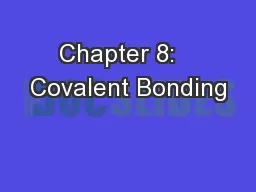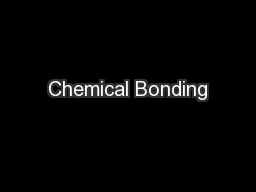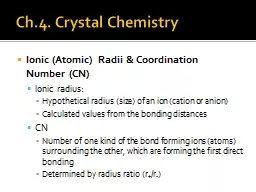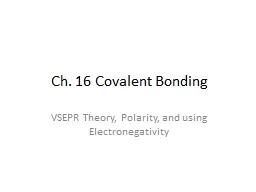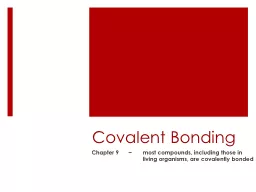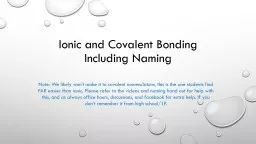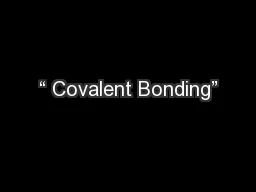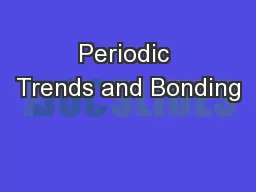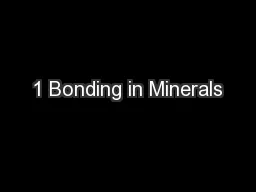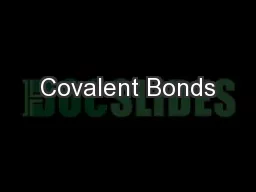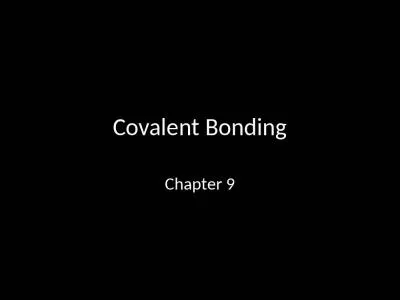PPT-Chapter 8: Covalent Bonding
Author : pamella-moone | Published Date : 2018-10-28
Matter takes many forms in nature In this chapter we are going to learn to distinguish the type of compound that we have already studied the ionic compound which
Presentation Embed Code
Download Presentation
Download Presentation The PPT/PDF document "Chapter 8: Covalent Bonding" is the property of its rightful owner. Permission is granted to download and print the materials on this website for personal, non-commercial use only, and to display it on your personal computer provided you do not modify the materials and that you retain all copyright notices contained in the materials. By downloading content from our website, you accept the terms of this agreement.
Chapter 8: Covalent Bonding: Transcript
Matter takes many forms in nature In this chapter we are going to learn to distinguish the type of compound that we have already studied the ionic compound which contains oppositelycharged particles metal . and . Electronegativity. Presented by . Leticia Bonita Prince. Newcastle University 4. th. Year . MChem. Student. Aims of Today. Increase your understanding of bonding and electronegativity. Increase your spatial skills and awareness using software designed by the CCDC. Introduction to Chemical Bonding. Introduction to Chemical Bonding. Objectives:. Define . chemical bond.. Explain why most atoms form chemical bonds.. Describe ionic and covalent bonding.. Explain why most chemical bonding is neither purely covalent nor purely ionic.. . Ionic (Atomic) Radii & Coordination Number (CN). Ionic radius: . Hypothetical radius (size) of an ion (. cation. or anion). Calculated values from the bonding distances. CN. Number of one kind of the bond forming ions (atoms) surrounding the other, which are forming the first direct bonding. IB Topics 4 & 14. Text:. Ch 8 (all except sections 4,5 & 8). Ch 9.1 & 9.5. Ch 10.1-10.7. My Name is Bond. Chemical Bond. PART 5: Giant Covalent Structures, Metallic Bonding & Physical Properties. VSEPR Theory, Polarity, and using . Electronegativity. Covalent . Bonds. Forms when 2 atoms share a pair of valence e. -. A. Types of Covalent Bonds. 1. . Single Covalent Bond . – two atoms share . Chapter 9 ~ most compounds, including those in living organisms, are covalently bonded. What You’ll Learn. I will analyze the nature of a covalent bond. I will name covalently bonded groups of atoms. Including Naming. Note: We likely won’t make it to covalent nomenclature, this is the one students find FAR easier than ionic. Please refer to the videos and naming hand out for help with this, and as always office hours, discussions, and . Ball-and-stick model. Molecular . Compounds. OBJECTIVES:. Distinguish. between the melting points and boiling points of . molecular. compounds and . ionic. compounds.. Molecular . Compounds. OBJECTIVES:. Higher Supported Study - Week 2 . Key Areas – Periodic Trends . The trends in . covalent radius . across periods and down groups.. The trends in . ionisation energies . across periods and down groups. . The Glue That Holds Minerals Together . GLY . 4200 – Fall. , 2016. 2. Types of Bonds. Intramolecular. Ionic. Covalent. Metallic. Intermolecular. Hydrogen. Van der Waals. 3. Definition of Bonding. A chemical bond is an attraction between atoms brought about by:. IB Topics 4 & 14. Text:. Ch 8 (all except sections 4,5 & 8). Ch 9.1 & 9.5. Ch 10.1-10.7. My Name is Bond. Chemical Bond. PART 5: Giant Covalent Structures, Metallic Bonding & Physical Properties. Types of bonds. Ionic bonding. results from electrostatic attractions among ions, which are formed by the . transfer. of one or more electrons from one atom to another.. Covalent bonding. results from . Do . Now: Identify . Bond Type from Formula. Au. Ag. CO. 2. Li. 3. N. Na. 2. S. Mg. CsF. H. 2. O. NaCl. SO. 2. Cu. CH. 4. Covalent. Covalent. Covalent. Covalent. Ionic. Ionic. Ionic. Ionic. Metallic. The Covalent Bond. Section 9.1. Worldwide, scientists are studying ways to increase food supplies, reduce pollution, and prevent disease. Understanding the chemistry of compounds that make up fertilizers, pollutants, and materials that carry genetic information is essential in developing new technologies in these areas. An understanding of the chemistry of compounds requires an understanding of their bonding..
Download Document
Here is the link to download the presentation.
"Chapter 8: Covalent Bonding"The content belongs to its owner. You may download and print it for personal use, without modification, and keep all copyright notices. By downloading, you agree to these terms.
Related Documents

